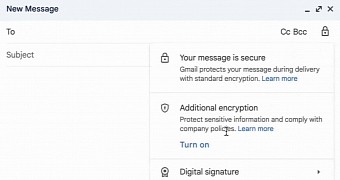Google has recently announced that Gmail for the web is getting client-side encryption for more customers.
Already available for some Workspace subscribers, the client-side encryption in Gmail on the web is being expanded to Workspace Enterprise Plus, Education Plus, and Education Standard customers.
Worth knowing, however, is that the feature remains exclusive to customers who enroll in the beta program, with Google not yet sharing an ETA as to when the broad availability is supposed to be reached.
The Mountain View-based search giant explains that with end-to-end encryption, the content of emails, including the body and the attachments, can’t be decrypted, even if they are stored on Google servers.
“Using client-side encryption in Gmail ensures sensitive data in the email body and attachments are indecipherable to Google servers. Customers retain control over encryption keys and the identity service to access those keys,” Google explains.
“Google Workspace already uses the latest cryptographic standards to encrypt all data at rest and in transit between our facilities. Client-side encryption helps strengthen the confidentiality of your data while helping to address a broad range of data sovereignty and compliance needs. Client-side encryption is already available for Google Drive, Google Docs, Sheets, and Slides, Google Meet, and Google Calendar (beta).”
Google explains that customers need to apply for the beta, but even so, the end-to-end encryption will then be turned off by default and IT admins will have to enable it manually.
For the time being, the feature isn’t available for users with personal Google accounts and for Google Workspace Essentials, Business Starter, Business Standard, Business Plus, Enterprise Essentials, Education Fundamentals, Frontline, and Nonprofits, as well as legacy G Suite Basic and Business customers.
Google hasn’t shared any details as to when it plans to expand the availability of this feature to more Gmail on the web users.

 14 DAY TRIAL //
14 DAY TRIAL //